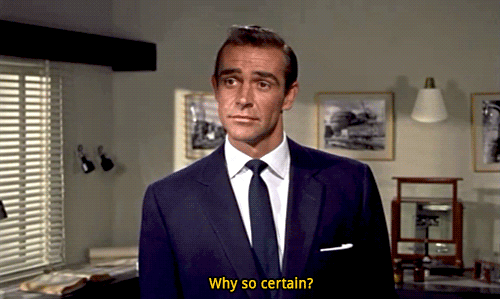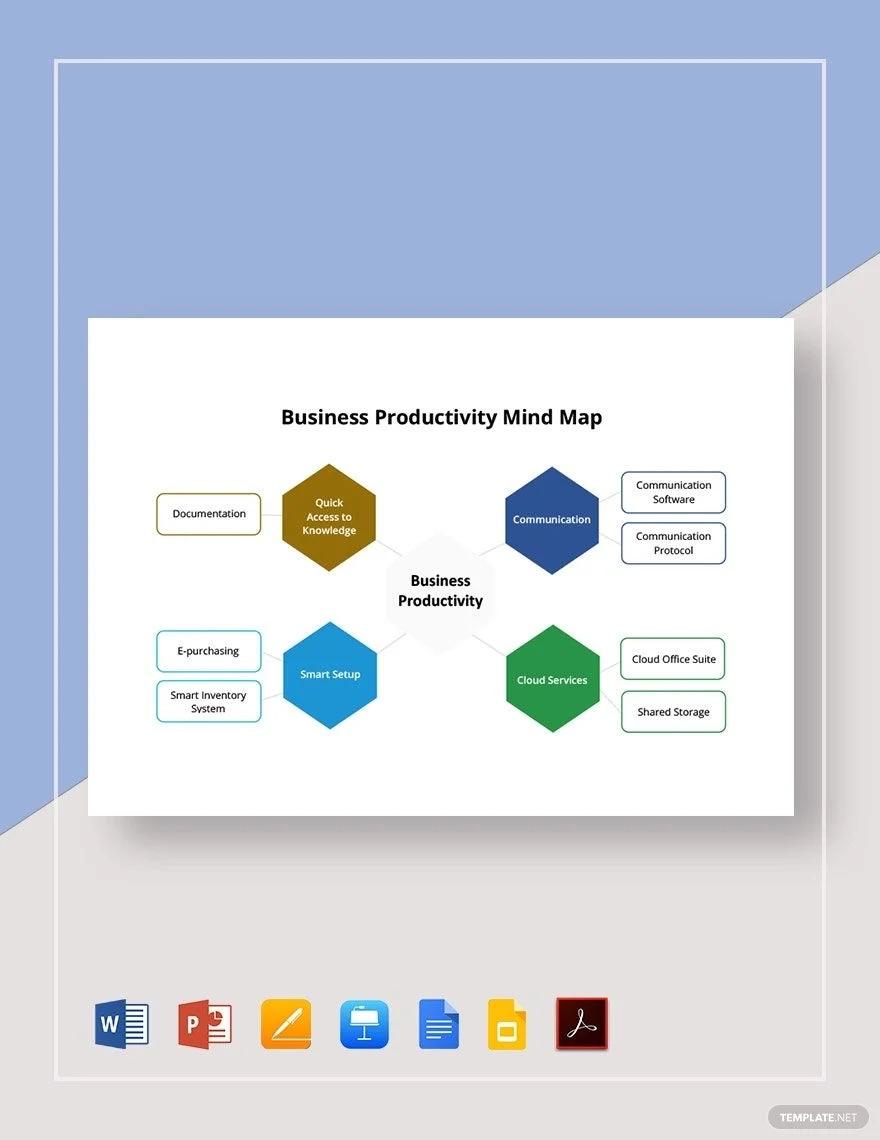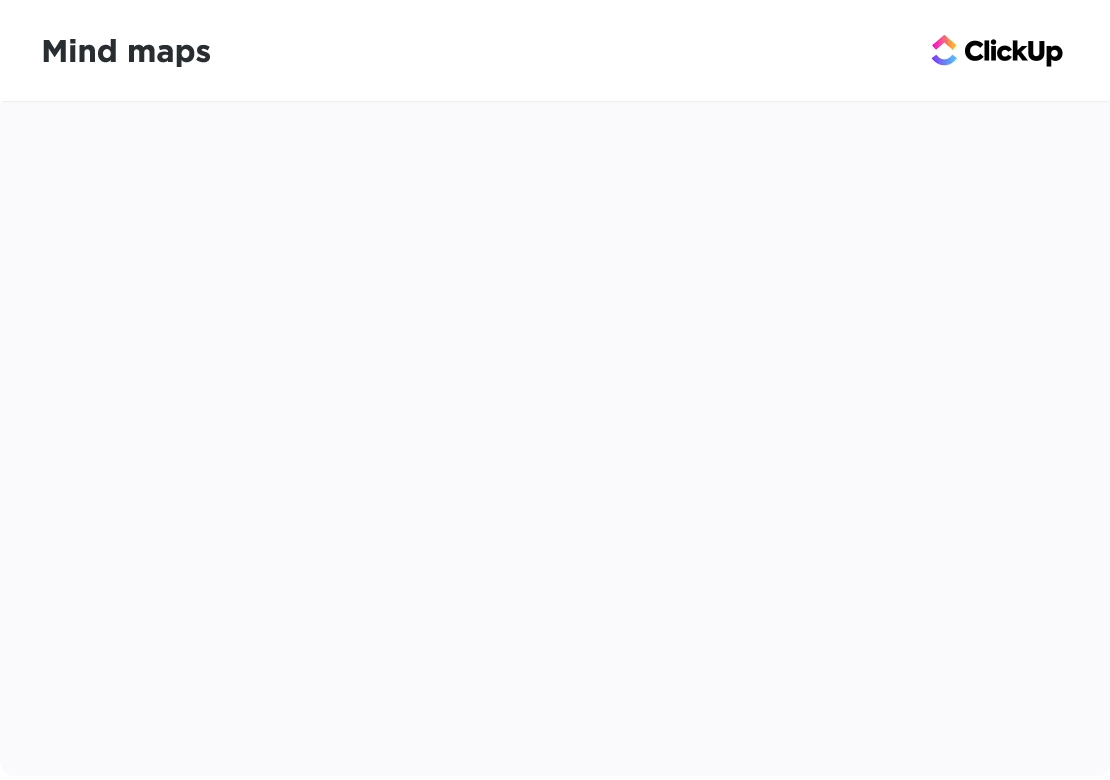Microsoft Word is a word processing program used for writing memos and building reports, but it can also be used to make mind maps! A mind map is a flexible project management tool used to organize information and ideas.
In this guide, we’ll walk through how to create three versions of a mind map in Word, quick tips for mind mapping productivity, and a Word alternative to make your mind maps come to life!
- What Is a Mind Map?
- ⭐ Featured Template
- How to Make a Mind Map in Word
- 7 Microsoft Word Tips and Tricks for Creating Mind Maps
- Free Mind Map Templates in Word
- 4 Major Drawbacks of Using Word to Create Mind Maps
- Bring Your Mind Maps to Life With ClickUp
- Beyond the Word Document: Create Mind Maps in ClickUp
⏰ 60-Second Summary
Mind maps are a great way to organize ideas, but Microsoft Word isn’t designed for them. Still, you can create one using different methods:
- SmartArt Graphics – Insert a Hierarchy Chart and add topics
- Basic Shapes – Draw circles, rectangles, and lines to structure ideas
- Text-Based Mapping – Format text with colors and spacing for a simple outline
While Word provides a basic way to create mind maps, it can be difficult to edit, expand, or collaborate on them effectively.
A more flexible alternative: ClickUp Mind Maps
ClickUp makes mind mapping easier with a drag-and-drop interface, task integration, and real-time collaboration. Instead of manually formatting in Word, you can create, edit, and share mind maps seamlessly.
What Is a Mind Map?
A mind map is a non-linear flowchart that breaks down a central concept into digestible, related concepts. Mind maps help us learn better and faster than a traditional outline because they echo how our minds create—in images!
⭐ Featured Template
Not able to automate your tasks in the created mind map in word? use ClickUp’s Simple Mind Map Template that enables automation and easier use and workflow.
Not to say that you have to be a designer to create a mind map. This versatile tool is for all types of ideas and projects! Mind maps can help from planning marketing campaigns to collecting information about a key subject.
Mind Mapping Examples for Work and Life
🌐 Strategy Mind Maps
- Internal Communication Plan
- Business Growth Strategy
- OKRs
- Case Study Analysis
🎨 Creative Mind Maps
- Brainstorming and Development
- Infographic Presentation
- Procedures and Systems
- Onboarding
🧠 Personal Mind Maps
- Roadmaps
- Procedures and Systems
- Time Management and Priorities
- Organization charts
- Interview Preparation
👉 Check out more mind map examples!
How to Make a Mind Map in Word
Note: In this tutorial, we use Microsoft Word for Mac Version 16.54. The steps and features may look different if you’re on another platform or version.
📈 Version 1: SmartArt Graphic

1. Open Microsoft Word
2. Select Blank Document > Create to open a new Word document
3. Under the Layout tab, select Orientation > Landscape
4. Under the Layout tab, select Margins > Narrow
Optional: To change the page color, go to the Design tab > Page Color > pick a color to apply
5. Add your document title at the top of the page, align to the center, change the font type (if desired) and increase the font size
6. Go to the Insert tab > SmartArt > Hierarchy > Horizontal Hierarchy
7. From the Text Pane dialog box, add your Central Idea, Topics, and Subtopics
- Press the
Returnkey to add more text fields for key information andShiftkey to create a bullet point for details underneath the key information
🔸 Version 2: Basic Shapes

1. Open Microsoft Word
2. Select Blank Document > Create to open a new Word document
3. Under the Layout tab, select Orientation > Landscape
4. Under the Layout tab, select Margins > Narrow
Optional: To change the page color, go to the Design tab > Page Color > pick a color to apply
5. Add your document title at the top of the page, align to the center, change the font type (if desired) and increase the font size
6. Start with the Central Idea shape: Under the Insert tab > select Shapes > click any desired shape > draw the shape in the center
7. Next, choose a different shape for the Topics: Under the Insert tab > select Shapes > click any desired shape > draw the shape surrounding the Central Idea
8. Then, choose another shape for the Subtopics: Under the Insert tab > select Shapes > click any desired shape > draw the shape surrounding the Central Idea
9. Finally, insert straight lines to represent relationships between the Central Idea, Topics, and Subtopics: Under the Insert tab > select Shapes > Line > draw the line to connect two shapes
📓 Version 3: Text-Based

1. Launch Microsoft Word
2. Select Blank Document > Create to open a new Word document
3. Under the Layout tab, select Orientation > Landscape
4. Under the Layout tab, select Margins > Narrow
Optional: To change the page color, go to the Design tab > Page Color > pick a color to apply
5. Add your document title at the top of the page, align to the center, change the font type (if desired) and increase the font size
6. Double click anywhere on your Word document to add text (or insert text boxes)

7 . To categorize your Central Idea, Topics, and Subtopics, highlight the text go to Home tab > Font Color > click a color to apply
8. Under the Insert tab > select Shapes > Line > draw the line to connect two shapes

💡 Pro Tip: Leverage AI tools to visualize your ideas faster. ClickUp Brain, ClickUp’s built-in AI assistant, can help you generate illustrations and visuals via whiteboards. See how! 👇🏼

7 Microsoft Word Tips and Tricks for Creating Mind Maps
1️⃣ Change the system’s default font
If you find yourself constantly changing the font before you do anything else on your Word document, change the system’s default font:
1. Under Format, select Font
2. Change the Font, Font Style, or Size
3. At the bottom left corner of the dialog box, click Default
4. Choose whether you want to set the default font for the current document or all documents based on the standard template
5. Click OK

2️⃣ Add your most-used commands to the Quick Access Toolbar
Most of us use about 25% percent of Microsoft Word’s Ribbon toolbar, yet we still have to flip through multiple functions to get there. Fill your Quick Access Toolbar with your most-used commands (creating a text box, inserting shapes, and more) for fewer clicks!
1. Click on the ellipses (three dots icon) in the toolbar and select More Commands
2. Select any command from the left column and click on the right arrow to move the command to the right column
3. Remove a command from the left column by selecting the back arrow
4. Click Save

3️⃣ Turn images into shapes
Add a personal touch or visual aids to support your presentation by inserting images and formatting them into shapes to make them contemporary. Here’s how:
1. Drag and drop a photo directly into the Word application or go to the Insert tab > Pictures and import a file
2. Select your file
3. Under the Picture Format tab > click the arrow next to Crop to modify the photo into any shape or ratio
4. Hold the Shift key and click and drag one of the corners to adjust the size ⬇️

4️⃣ Lorem Ipsum Text
In a pinch and need some filler content? Use the Lorem command to quickly insert placeholder text so you can keep the wheels turning on your mind map. Here’s how:
1. Place the cursor where you want the placeholder text to start
2. Type =lorem(number of paragraphs, number of sentences)

5️⃣ Create a color palette for repeated use
You’ll create a professional document in half the time by using color themes, and your colleagues will appreciate the consistency. So often, we get stuck on figuring out what colors work together. That stops today!
The mind map versions we covered above used this same color palette. ⬇️

6️⃣ Change the system’s “Default Line” shape and color
Save your perfect mind map line by making it the default line in Word. This will drastically reduce the amount of time spent copying, pasting, and formatting a new line every time. Then, save it to your Quick Access Toolbar (mentioned in tip #2)! To set a new default line:
1. Right-click the line
2. Select Set as Default Line
3. Change the default line when you find a new favorite or want to go back to Word’s original line!

7️⃣ Build a template library
Save your custom mind map template for the next time you sit down to create a mind map. You’ll have the setup already done this way, and you can get right to work! Save a template with these steps:
1. Go to File > Save as Template, and a dialog box will appear
2. Enter your calendar template name under Save As
3. Add relevant tags under Tags (for Mac users)
4. Choose where you want to save your calendar template
5. Check the File Format is set to Microsoft Word template (.dotx)
6. Click Save

Free Mind Map Templates in Word
Speaking of templates, here are free timeline templates you can download right away or use as inspiration for your next mind map or concept map.
Microsoft Word Mind Map Graphic Organizer Template by Template.net

The Microsoft Word Mind Map Graphic Organizer Template by Template.net is a professionally designed tool ideal for organizing your thoughts, ideas, or concepts in a visual form. This user-friendly template incorporates a clear, minimalistic design, enabling everyone, from students to professionals, to create visually appealing mind maps effortlessly.
Importantly, the template is fully customizable and compatible with all versions of Microsoft Word, providing convenience and flexibility to meet your specific needs. Perfect for project management, decision making, strategic planning, or brainstorming sessions, it’s an excellent resource to streamline any process that benefits from visual representation.
📮ClickUp Insight: 37% of workers send follow-up notes or meeting minutes to track action items, but 36% still rely on other, fragmented methods.
Without a unified system for capturing decisions, key insights you need may get buried in chats, emails, docs or spreadsheets. With ClickUp, you can instantly turn conversations into actionable tasks across all your tasks, chats, and docs—ensuring nothing falls through the cracks.
Microsoft Word Business Productivity Mind Map Template by Template.net

The Microsoft Word Business Productivity Mind Map Template by Template.net is an exceptional tool designed specifically for business professionals. This template is an effective means of graphically illustrating and connecting complex business concepts, objectives, or strategies. It encompasses a professional-grade layout which allows for easy customization, ensuring that your mind map meets your business’s exact needs.
Compatible with all versions of Microsoft Word, this template is highly adaptable and ideal for enhancing productivity, streamlining project management, fostering team collaboration, or facilitating effective decision-making. If you’re looking for a way to boost your business’s productivity through better visualization, this mind map template is your go-to resource.
4 Major Drawbacks of Using Word to Create Mind Maps
Though Microsoft Word is one of the most popular software available, it is limited to the demands and changes of a modern workforce and you may need to check out MS Word alternatives. Even performing the most basic actions to create a simple table took many clicks and careful navigation to complete our timeline build.
Here’s what you should know before investing time, energy, and resources in Microsoft Word:
- It’s challenging to use: The Ribbon toolbar is different from version to version, so there’s an unnecessary complexity to learning where (and how) the creation and drawing tools work. You’ll most likely spend most of your time searching the web for support articles
- It’s expensive: Other Office programs—Microsoft Word, Microsoft Powerpoint, Microsoft Excel, and more are pricey. (The Word application alone starts at $159.99!)
- Too many options: Decision paralysis will creep around the corner if you’re in the weeds of formatting. Trying to carry out simple tasks like inserting and adding basic lines are time-consuming because of the lack of intuitiveness in Word’s Ribbon toolbar
- No automation: Word is not optimized as a mind mapping software with automation capabilities
You’ll want that.
Why? Powerful mind mapping tools help prioritize tasks faster, smarter, and efficiently. Project managers have to regularly update and share mind maps, so they’ll need project software to familiarize themselves, the team, stakeholders, and clients.
If you want to save time while improving the quality of your work and collaboration, try creating mind maps in ClickUp! ✨
Related Resources:
- How to Create a Mind Map in Excel
- How To Create A Project Timeline In Excel
- How to Make a Timeline in Word
- How to Make A Calendar in Word
- How to Make a Timeline in Google Docs
- How to Create a Gantt Chart in Word
- How to Make a Fillable Form in Word
- How to Make a Flowchart in Word
- Concept Map Templates
- How to Make a Mind Map in Google Docs
Bring Your Mind Maps to Life With ClickUp
ClickUp is the ultimate productivity platform for teams to manage projects, collaborate smarter, and bring all work under one tool. Whether you’re new to productivity apps or a seasoned project manager, ClickUp’s customization can stretch to any team size for organized and connected work.
ClickUp Mind Maps not only create the space to expand and stretch your ideas, but you can also use them to build off the tasks and projects you’ve already created in ClickUp.
- Quickly create, edit, and delete tasks (and subtasks) right from your Mind Map view
- Create in Blank mode where nodes don’t have to connect to any task structure—free form mind mapping at its best!
- Drag branches to adjust where nodes are located and organize them into logical paths
- Apply a filter to hide all empty branches for clean visibility
- Share your Mind Maps with anyone outside your Workspace to keep everyone up to date on how your project is progressing, and more
- Pre-made templates like ClickUp’s Simple Mind Map Template to easily get started with ClickUp Mind Maps!
Beyond the Word Document: Create Mind Maps in ClickUp
While it’s a handy skill to build mind maps in Word, it’s not the most convenient application for time management and building meaningful relationships. Try ClickUp today and solve problems in half the time it would take to draw individual lines in Word! 🚀







